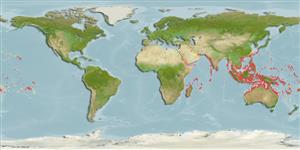>
Eupercaria/misc (Various families in series Eupercaria) >
Labridae (Wrasses) > Corinae
Etymology: Hemigymnus: Greek, hemi = half + Greek, gymnos = naked (Ref. 45335).
More on author: Bloch.
Environment: milieu / climate zone / depth range / distribution range
Sinh thái học
Biển Cùng sống ở rạn san hô; Mức độ sâu 0 - 30 m (Ref. 9710), usually 5 - 30 m (Ref. 27115). Tropical; 24°C - 28°C (Ref. 27115); 30°N - 36°S, 24°E - 138°W
Indo-West Pacific: Rde Sea, East Africa to Samoa; north to Ryukyu Is.; south to Australia.
Bộ gần gũi / Khối lượng (Trọng lượng) / Age
Maturity: Lm ? range ? - ? cm
Max length : 39.6 cm TL con đực/không giới tính; (Ref. 125598); Khối lượng cực đại được công bố: 1.3 kg (Ref. 125598)
Các tia vây lưng cứng (tổng cộng) : 9; Các vây lưng mềm (tổng cộng) : 10 - 11; Tia cứng vây hậu môn: 3; Tia mềm vây hậu môn: 11. This species is distinguished by the following characters: gill rakers 26-29; small juveniles dark brown, green on snout and interorbital, with a slightly oblique white bar from front of dorsal fin to abdomen, and 2 narrow pale yellowish bars below soft portion of dorsal fin that fade ventrally; larger juveniles have a white bar from origin of dorsal fin, passing beneath pectoral fin onto abdomen; head and body anterior to bar greyish green, posterior to bar black; posterior caudal peduncle and caudal fin yellow, often with 1 or 2 small black spots centrally near base: small females with body posterior to a curving demarcation between origins of dorsal and anal fins blackish with a narrow dark greenish bar on each scale, grading to yellow with blue-green spots posteriorly on caudal peduncle and fin; large females dark green posterior to oblique demarcation on body, the scales rimmed in black, with a vertical green line or spot on each scale; head and anterior body light green dorsally, pale blue-green ventrally, have irregular bands on snout and above eye, and a large complex marking behind eye; body of males posterior to demarcation dark green, each scale with narrow pale blue-green and black posterior margin; head green dorsally with irregular green to blue-green bands, including a blue ring around eye; cheek and operculum pinkish white with irregular light blue lines and spots, except for a large yellowish green blotch centrally on cheek without markings; lips and ventral part of head mainly pale blue; chest and abdomen pinkish white with a light blue spot or arc on scales (Ref. 93095).
Found in subtidal reef flats and lagoon and seaward reefs. Juveniles occur inshore, found among branching corals while adults found in areas of mixed sand, rubble, and coral (Ref. 9710). Large adults in deeper water (Ref. 48636). Maximum length beyond 45 cm TL is unlikely, with largest measured individual at 37 cm TL (Ref, Feeds mainly on small invertebrates, especially crustaceans, polychaete worms, mollusks and brittle stars (Ref. 9823). Diet changing from primarily demersal planktonic crustaceans to hard-shelled invertebrates with growth (Ref. 37816). Minimum depth reported taken from Ref. 128797.
Life cycle and mating behavior
Maturities | Sự tái sinh sản | Spawnings | Egg(s) | Fecundities | Ấu trùng
Oviparous, with distinct pairing during breeding (Ref. 205).
Randall, J.E., 2013. Review of the Indo-Pacific labrid fish genus Hemigymnus. J. Ocean Sci. Found. 6:2-18. (Ref. 93095)
IUCN Red List Status (Ref. 130435)
Threat to humans
Harmless
Human uses
Các nghề cá: buôn bán nhỏ; cá để chơi: đúng; Bể nuôi cá: Tính thương mại
Các công cụ
Special reports
Download XML
Các nguồn internet
Estimates based on models
Preferred temperature (Ref.
123201): 24.6 - 29, mean 27.8 °C (based on 1006 cells).
Phylogenetic diversity index (Ref.
82804): PD
50 = 0.6250 [Uniqueness, from 0.5 = low to 2.0 = high].
Bayesian length-weight: a=0.01318 (0.00824 - 0.02108), b=3.06 (2.92 - 3.20), in cm total length, based on LWR estimates for this species & (Sub)family-body (Ref.
93245).
Mức dinh dưỡng (Ref.
69278): 3.6 ±0.45 se; based on food items.
Thích nghi nhanh (Ref.
120179): Trung bình, thời gian nhân đôi của chủng quần tối thiểu là 1.4 - 4.4 năm (Preliminary K or Fecundity.).
Fishing Vulnerability (Ref.
59153): Low to moderate vulnerability (30 of 100).
Nutrients (Ref.
124155): Calcium = 28.8 [15.3, 87.8] mg/100g; Iron = 0.544 [0.320, 0.977] mg/100g; Protein = 18.6 [15.7, 20.8] %; Omega3 = 0.154 [0.078, 0.309] g/100g; Selenium = 31.1 [11.2, 81.1] μg/100g; VitaminA = 115 [36, 396] μg/100g; Zinc = 2.73 [0.87, 4.69] mg/100g (wet weight);
